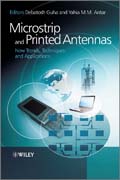
Microstrip and printed antennas: new trends, techniques and applications
Guha, Debatosh
Antar, Yahia M.M.
Attention is given to fundamental concepts and techniques, their practical applications and the future scope of developments. Several topics, essayed as individual chapters include reconfigurable antenna, ultra-wideband (UWB) antenna, reflectarrays, antennas for RFID systems and also those for body area networks. Also included are antennas using metamaterials and defected ground structures (DGSs). Essential aspects including advanced design, analysis and optimization techniques based on the recent developments have also been addressed INDICE: Table of contents Chapter 1 Numerical Analysis Techniques Ramesh Garg, Indian Institute of Technology, Kharagpur, India 1.1 Standard (Yees) FDTDMethod 1.2 Numerical Dispersion of FDTD Algorithms and Hybrid Schemes 1.3 Stability of Algorithms 1.4 Absorbing Boundary Conditions 1.5 LOD-FDTD Algorithm 1.6 Robustness of Printed Patch Antennas 1.7 Thin Dielectric Approximation 1.8Modeling of PEC and PMC for Irregular Geometries Chapter 2 Computer Aided Design of Microstrip Antennas Debatosh Guha, Institute of Radio Physics and Electronics, University of Calcutta, India Jawad Y. Siddiqui, Institute of Radio Physics and Electronics, University of Calcutta, India 2.1 Introduction 2.2 Microstrip Patch as Cavity Resonator 2.3 Resonant Frequency of Circular MicrostripPatch (CMP) 2.4 Resonant Frequency of Rectangular Microstrip Patch (RMP) withVariable Air Gap 2.5 Resonant Frequency of an Equilateral Triangular Microstrip Patch (ETMP) with Variable Air Gap 2.6 Input impedance of a Microstrip Patch 2.7 Feed Reactance of a Probe-Fed Microstrip Patch 2.8 Radiation Characteristics 2.9 Radiation Efficiency 2.10 Bandwidth 2.11 Conclusion 2.12 References Chapter 3 Generalized Scattering Matrix Approach for Multilayer Patch Arrays Arun K. Bhattacharyya 3.1 Introduction 3.2 Outline of the GSM Approach 3.3 Mutual Coupling Formulation 3.4 Finite Array: Active Impedance and Radiation Patterns 3.5 Numerical Example 3.6 Conclusions 3.7 References Chapter 4 OptimizationTechniques for Planner Antennas Rabindra K. Mishra, Electronic Science Department, Berhampur University 4.1 Basic Optimization Concepts 4.2 Real Coded Genetic Algorithm (RCGA) 4.3 Neurospectral Design of Rectangular Patch Antenna 4.4Inset-fed Patch Antenna Design Using Particle Swarm Optimization 4.5 Conclusion 4.6 References Chapter 5 Microstrip Reflectarray Antennas Jafar Shaker, Communication Research Centre Canada, Ottawa, Ontario Reza Chaharmir, Communication Research Centre Canada, Ottawa, Ontario 5.1 Introduction 5.2 General Reviewof Reflectarrays: Mathematical Formulation and General Trends 5.3 Comparison of Reflectarray and Conventional Parabolic Reflector 5.4 Cell Elements and Specific Applications: A General Survey 5.5 Wideband Techniques for Reflectarrays5.6 Development of Novel Loop-Based Cell Elements 5.7 Summary 5.8 References Chapter 6 Reconfigurable Microstrip Antennas J. T. Bernhard, University of Illinois at Urbana-Champaign, USA 6.1 Introduction 6.2 Substrate Modification forReconfigurability 6.3 Conductor Modification for Reconfigurability 6.4 Enabling Reconfigurability: Considerations for Reconfiguration Mechanisms 6.5 FutureTrends in Reconfigurable Microstrip Antenna Research and Development 6.6 References Chapter 7 Wearable Antennas for Body Area Networks Peter S Hall and Yang Hao 7.1 Introduction 7.2 Sources on the human body 7.3 Narrowband antennas 7.4 Fabric Antennas 7.5 Ultra Wideband Antennas 7.6 Multiple antenna systems 7.7 Conclusions 7.8 References Chapter 8 Printed Antennas for Wireless Communications Satish K. Sharma, San Diego State University, USA Lotfollah Shafai, University of Manitoba, Canada 8.1 Introduction 8.2 Broadband Microstrip Patch Antennas 8.3 Patch Antennas for Multiband Wireless Communications 8.4 Enhanced Gain Patch Antennas 8.5 Wideband Compact Patch Antennas 8.6 Microstrip Slot Antennas 8.7 Microstrip Planar Monopole Antenna 8.8 References Chapter 9 UHF Passive RFID Tag Antennas Daniel Deavours, University of Kansas, USA Daniel Dobkin,Enigmatics, USA 9.1 Introduction 9.2 Application Requirements 9.3 Approaches 9.4 Fabrication 9.5 Review Chapter 10 Printed UWB Antennas Zhi Ning Chen, Institute for Infocomm Research, Singapore. Xianming Qing, Institute for Infocomm Research, Singapore Shie Ping Terence See, Institute for Infocomm Research, Singapore 10.1 Introduction 10.2 Swan Antenna with Reduced Ground Plane Effect 10.3 Slim UWB Antenna 10.4 Diversity Antenna 10.5 Printed Slot UWB Antenna and Band-Notched Solutions Chapter 11 Metamaterial Antennas and Radiative Systems Christophe Caloz, École Polytechnique, Montreal, Canada 11.1 Introduction 11.2Fundamentals of Metamaterials 11.3 Leaky-Wave Antennas 11.4 Resonant Antennas11.5 Exotic Radiative Systems Chapter 12 Defected Ground Structure For Microstrip Antennas Debatosh Guha, University of Calcutta, India Sujoy Biswas, Institute of Technology and Marine Engineering, India Yahia M. M. Antar, Royal Military College, Kingston, Ontario, Canada 12.1 Introduction 12.2 Fundamentals ofDGS 12.3 DGS for controlling Microstrip Antenna Feeds and Front-End Characteristics 12.4 DGS to Control/Improve Radiation Properties of Microstrip Patch Antennas 12.5 DGS for Reduced Mutual Coupling between Microstrip Array Elements and Associated Improvements Chapter 13 Printed Leaky Wave Antennas Samir F. Mahmoud, University of Kuwait, Kuwait Yahia M.M. Antar, Royal Military College of Canada, Kingston, Ontario 13.1 Introduction 13.2 The leaky wave as a complexplane wave 13.3 Radiation pattern of a leaky wave 13.4 Examples of leaky modesupporting structures 13.5 The excitation problem and derivation of radiationfields 13.6 Two Dimensional Leaky Waves 13.7 Further advances on a class of periodic leaky wave antennas
- ISBN: 978-0-470-68192-3
- Editorial: John Wiley & Sons
- Encuadernacion: Cartoné
- Páginas: 481
- Fecha Publicación: 01/01/2011
- Nº Volúmenes: 1
- Idioma: Inglés
